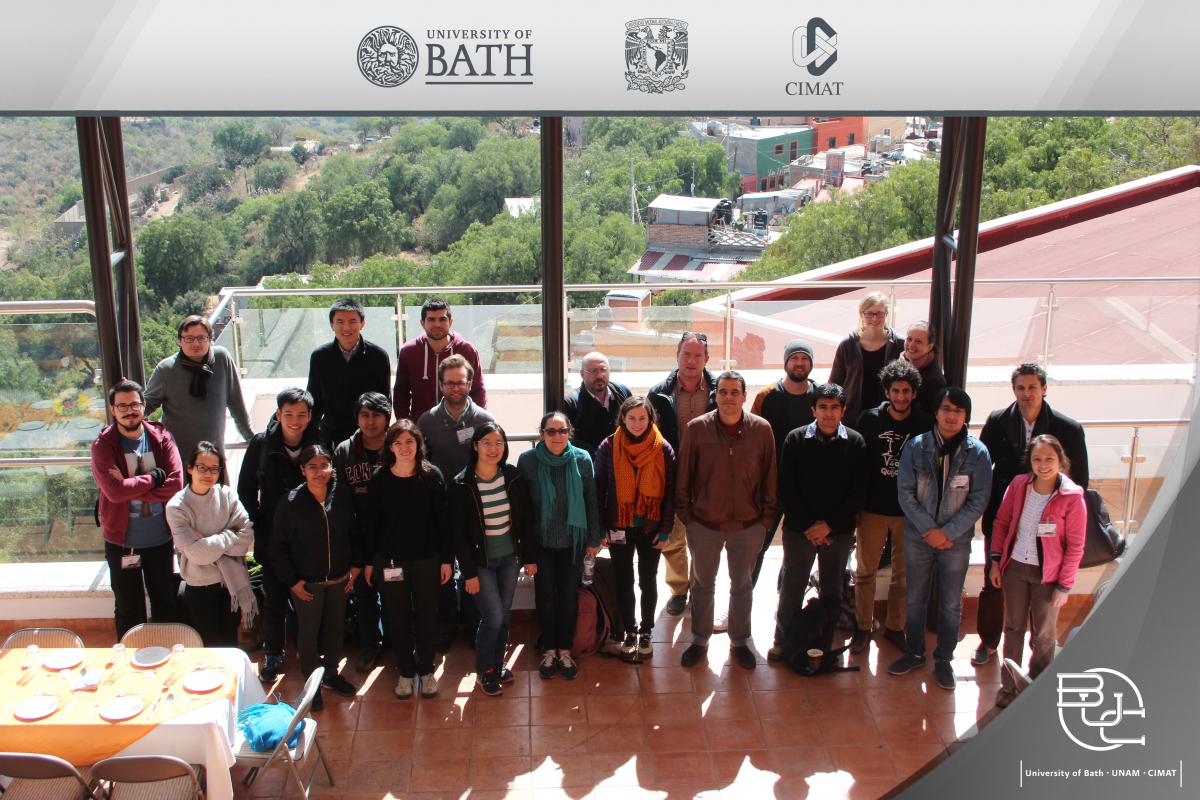Overview
This meeting has been delayed until December 2017 due to last minute issues.
New date: 11th-15th December 2017
The purpose of this meeting is allow for an update in progress between the Mexican and Prob-L@B communities in the field of branching processes and related topics with participation from other international partners. The programme consists of recent results and time for collaborative work as new project fomrulation.

Organizers
Andreas Kyprianou (University of Bath, UK)
Juan Carlos Pardo (CIMAT, México)
Courses
|
Course |
Title |
|
A Gabriel Berzunza (University of Gottingen)
|
The pruning process on trees Aldous and Pitman introduced a tree-valued Markov chain by pruning off more and more sub-trees along the edges of a Galton-Watson tree. More generally, Abraham and Delmas defined a non-uniform pruning process on the branch points of a Galton-Watson tree. In the same spirit, some authors have considered the continuum tree analogues (i.e. Lévy trees) of pruning dynamics. The aim of this mini course is to present a topology which allows to link the discrete and continuum tree-valued dynamics. Roughly speaking, we construct the pruning process on the space of so-called bi-measure trees, which are metric measure spaces with an additional pruning measure.
|
|
B Sandra Palau (University of Bath)
|
Brownian web and net The Brownian web is a collection of one-dimensional coalescing Brownian motions starting |
|
C Alex Watson(University of Manchester)
Quan Shi (University of Oxford)
|
Growth-fragmentations and random planar maps Alex Notes
Fragmentation models incorporating growth have a long history in biological applications, but only recently have we been able to study general growth-fragmentation models from a probabilistic viewpoint. The framework of Bertoin and coauthors gives a construction of Markovian growth-fragmentation processes in a very general setting; these processes are interesting in themselves, but they can also be used to describe the size of cycles in certain random planar maps with boundary. In this course, we will discuss the construction and properties of growth-fragmentations, with a focus on the self-similar case, and outline the connection with random planar maps.
|
|
D Minmin Wang (University of Bath)
|
Scaling limits of inhomogeneous trees and graphs The aim of this mini course is to discuss some recent developments on the scaling limits of critical inhomogeneous graphs. We will see that the critical random graphs we consider are closely related to a family of Galton—Watson trees. Thus, our approach to the problem consists in analysing these Galton—Watson trees and their scaling limits, i.e. Lévy trees introduced by Le Gall & Le Jan.
|
|
E Adrian Gonzalez (UNAM)
|
The discrete ancestral selection graph In this mini curse we will talk about a random graph approach to population genetics which allow us to understand the relation between forward in time frequency processes (diffusions with jumps) and backwards in time ancestral processes (branching processes with interactions). |
Timetable
|
Monday |
|
|
08:30-09:30 |
Breakfast |
|
09:30-10:30 |
A |
|
10:30-10:45 |
Coffee |
|
10:45-11:45 |
B |
|
11:45-12:00 |
Coffee |
|
12:00-12:30 |
Arno Siri-Jégousse (UNAM): Poisson Dirichlet distributions applied to Coalescents We study three examples where the Poisson Dirichlet distribution for exchangeable partitions provides a straightforward tool to study functionals of coalescent proceses, eith a straightforward application ti population genetics. After recalling the celebrated Ewens' sampling formula for the Kingman coalescent, we will study the minimal clade size and the sites frequency spectrum of the Bolthausen-Sznitman coalescent. |
|
12:30-13:00 |
Juan Carlos Pardo (CIMAT): Extinction time of a CSBP with competition in a Lévy random environment In this talk, we are interested on the extinction time of continuous state branching processes with competition in a Lévy random environment. If the random environment is driven by a Brownian motion, we provide a Lamperti-type representation that allow us to get more interesting results regarding the extinction of such models.
|
|
13:00-15:00 |
Lunch |
|
15:00-17:00 |
Work sessions |
|
17:00-18:00 |
A |
|
18:00-20:00 |
Taquiza and fermented horse milk |
|
Tuesday |
|
|
08:30-09:30 |
Breakfast |
|
09:30-10:30 |
B |
|
10:30-10:45 |
Coffee |
|
10:45-11:45 |
A |
|
11:45-12:00 |
Coffee |
|
12:00-12:30 |
Cecile Mailler (University of Bath): Multi-drawing multi-colour urns A classical Pólya urn scheme is a Markov process whose evolution is encoded by a replacement matrix This talk will focus on multi-drawing Pólya urns, where the replacement rule depends on the random drawing of a set of m balls from the urn (with or without replacement). I will show how to apply stochastic approximation methods to get up-to-second-order limit theorems for balanced (but not “affine” urn schemes). This is a joint work with Nabil Lasmar and Olfa Selmi (Monastir, Tunisia).
|
|
12:30-13:00 |
Maria Clara Fitipaldi: Ray-Knight representation of Lévy-driven continuous-state branching Abstract: In this talk we talk about flows of branching processes with competition, which describe the evolution of general continuous state branching populations in which interactions between individuals give rise to a negative density dependence term. This generalizes the logistic branching processes studied by Lambert. Following the approach developed by Dawson and Li, we construct such processes as the solutions of certain flow of stochastic differential equations. We then propose a novel genealogical description for branching processes with competition based on interactive pruning of Lévy-trees, and establish a Ray-Knight representation result for these processes in terms of the local times of suitably pruned forests. |
|
13:00-15:00 |
Lunch |
|
15:00-17:00 |
Work sessions |
|
17:00-18:00 |
C |
|
Wednesday |
|
|
08:30-09:30 |
Breakfast |
|
09:30-10:30 |
B |
|
10:30-10:45 |
Coffee |
|
10:45-11:45 |
C |
|
11:45-12:00 |
Coffee |
|
12:00-13:00 |
D |
|
13:00-15:00 |
Lunch |
|
15:00-16:00 |
C |
|
Thursday |
|
|
08:30-09:30 |
Breakfast |
|
09:30-10:30 |
C |
|
10:30-10:45 |
Coffee |
|
10:45-11:45 |
D |
|
11:45-12:00 |
Coffee |
|
12:00-12:30 |
Liz Peñaloza Velasco: The shape of a seed bank tree The propose of this work is study the total lenght of a seed bank coalescent which is used to model the genealogies of population of plants and seeds where seeds can stay inactive for a long period. For statistical applications, we are only interested in the part of plants of the tree because the mutations can only occur on this side. To do this we define some useful stopping times like the first time that a plant becomes a seed and the first time that a seed becomes a plant, and we study the block counting process at those times. Also, we will use a connection with the Poisson-Dirichlet distribution to calculate the external branches lenght of the seed bank coalescent.
|
|
12:30-13:00 |
Airam Blancas (Frankfurt University):Marked metric spaces for finite populations Consider a finite population of individuals named Based on a joint work with S. Gufler, S. Kliem, V. C. Tran and A. Wakolbinger. |
|
13:00-15:00 |
Lunch |
|
15:00-17:00 |
Work sessions |
|
17:00-18:00 |
E |
|
Friday |
|
|
08:30-09:30 |
Breakfast |
|
09:30-10:30 |
E |
|
10:30-10:45 |
Coffee |
|
10:45-11:45 |
D |
|
11:45-12:00 |
Coffee |
|
12:00-12:30 |
Janos Englander (University of Colorado, Boulder):Survival asymptotics for branching random walks in IID environments ABSTRACT: We first study a model, introduced recently in [E and N. Sieben, 2011], of a critical Let Hence, the model exhibits `self-averaging' in the critical case but not in the subcritical one. I.e., in the first case, the asymptotic tail behavior is the same as in a `toy model' where space is removed, while in the second, the spatial survival probability is larger than in the corresponding toy model, suggesting spatial strategies. A spine decomposition of the branching process along with known results on random walks are utilized. This is joint work with Y. Peres (Microsoft Research). |
|
12:30-13:30 |
E |
|
13:30-15:00 |
Lunch |
|
15:00-17:00 |
Work sessions |
Participants
| Bath | CIMAT | UNAM | Other |
|---|---|---|---|
|
Andreas Kyprianou
Sandra Palau Emma Horton Dorottya Fekete Minmin Wang Tsogzolmaa Saizmaa Weerapat Satitkanitkul Isaac Gonzalez
Cecile Mailler
|
Juan Carlos Pardo
Victor Rivero
Rodrigo Gachuz
Jose Luis Perez
Antonio Murillo
Jose-Alfredo Mimbela
Ekaterina Todorova
Maria Fernanda Serna Mendoza
Eduardo Alvarez Rodríguez
Jose Alberto Tepox Mendez
Camilo González González
Natalia Cardona Tobón
Santiago Arenas Velilla
Jose de Jesus Contreras Arredondo
|
Arno Siri-Jégousse
Gerónimo Uribe Bravo
Adrian Gonzalez
Liz Peñaloza Velasco
Alejandro Hernández Wences
Maria Clara Fitipaldi
|
Janos Engländer
Alex Watson
Quan Shi
Gabriel Berzunza
Airam Blancas
Felipe Muñoz
|






